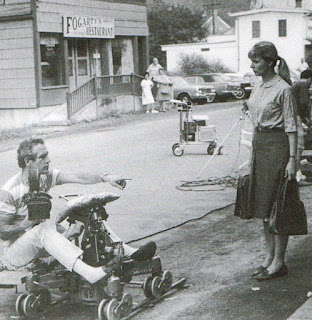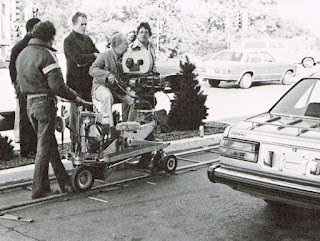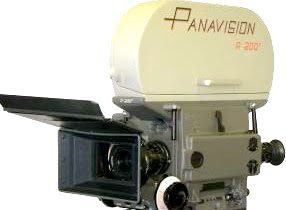The ingeniously designed and versatile Colortran Mini-Crab Dolly.
Manufacturing of the ingeniously designed
Colortran Mini-Crab Dolly started sometime around 1967. The
Colortran dollies were being produced up through 1975. A total of about 250 of these hand-built dollies were assembled at the
Berkey-
Colortran location on Chestnut Street in Burbank, California. This facility is now being used by another equipment outfit company, Chapman.
Based on Colortran's hefty $5825.00 price tag (see price list above), these dollies were made to order, not built and stockpiled. Back then it was actually cheaper to buy a brand new Cadillac Coupe DeVille ($5275.00) than a Colortran Mini-Crab Dolly.
The Colortran dolly was touted as being untippable and was known to accommodate the industry standard cameras of the time, Mitchell BNCR (130 lbs.) and the even beastlier, Panavison R-200 (160 lbs.). The Colortran is nearly as portable and versatile as a dolly could be. Before the advent of the Steadicam system, the Colortran was the answer to the big McAlister, Moviola Crab, Fearless and Fisher dollies, which were the standard on many film sets.
The Mini-Crab is a soft-riding, compact, nearly 300-pound platform that can steer effortlessly, crab 360 degrees and slip through a normal size doorway with ease. Even laden-down with two riders and a heavy camera, the Mini-Crab performs flawlessly. Other dollies particularly the larger crabs, i.e., Moviola, had a difficult time, if not impossible, maneuvering through tight spots such as doorways and corridors. Not the Mini-Crab!
In its day, another portable “crab” contender, the Elemack, challenged the Colortran. In my humble opinion, the Elemack lacked the versatility the Colortran offered. During my filmmaking days, I personally used an earlier version of the Elemack, called the “Spyder”. After a few weeks of working with the Elemack, which incidentally, was paired up with a "lighter" (80 pound) Panaflex camera, we were ready to ditch-it for a shopping cart!
As the dolly-grip for the above project, I remember operating the Elemack during several tracking shots when the ride became choppy.
Eventually, the DP, being totally exasperated with the ride, turned his head much in the same demonic fashion as 'Regan' did in 'The Exorcist'...he questioned me about the crappy push. None of us could figure out the reason of the rough ride. The choppiness came and went and occurred mostly on slow pushes.
After unbuckling the camera, we tipped the dolly over and did a complete check of each of the tires, wheels and lastly the wheel-bearings to make sure they were functioning properly. After more than an hour of trying to pin-point the problem, we gave up! We kept on shooting with a half-working Elemack until Victor Duncan sent over a sweet, battery-powered Fisher Dolly.
Other issues we had with the Elemack included the mechanism to disengage the opening/closing of the legs, which would never work right. This even after constant servicing through Victor Duncan of Detroit. Not to mention, using the manual foot-pump to jack-up the column was to say, tedious. On occasion, we would even find a puddle of hydraulic fluid underneath the Elemack, which I understand is common for this breed. Personally, it became a pain since it was I who was always wiping up after it!
The fact is, with the Elemack, you can't even lay a director's finder, lens or more importantly a cup of coffee down like you could on-top of the rubberized platform of the Colortran. After my experience with the Elemack, I'm convinced the Colortran Mini-Crab Dolly WAS and STILL IS the best designed 'vintage' portable crab dolly out there, especially given it's compact size. This made possible by its genius designer, William Sargent. Not only is the Colortran Mini-Crab American made, the build quality of that era is first-rate.
In short, if you're ever faced with renting or more importantly purchasing a crab-dolly, my advice would be...STAY AWAY from the Elemack brand. Especially, the Cricket and Spyder models.
If you're not lucky enough to find a Colortran Mini-Crab, I would suggest checking into a pre-owned Chapman. Yes, the Chapman's are pricey...but they will give you many years of trouble-free service. As mentioned earlier, the Chapman's are built at the same factory the Colortran's were assembled. In fact, I was told that many of the lathes and other machines that were once used to manufacture parts for the Colortran Mini-Crab's are still being used today to produce the Chapman's. Lastly, if you can't get your hands on a Chapman, I would then recommend a Fisher Dolly.
Now, back to the Colortran...if you were to flip the Mini-Crab dolly over and remove it's lower panel, you would see a maze of sophisticated engineering much akin to looking inside a fine Swiss watch. Hand-milled gears, forged steering controls, hydraulics, etc.
The Colortran dolly was built around an extremely heavy one-piece aluminum casting. It’s speculated that many of these dollies have found their way to the scrap-heap before their true identity became known. Stripped down, the empty shell of a Colortran Mini-Crab tips the scales with more than 175 pounds of solid, pure, high-grade extrusion aluminum. It’s conceivable; many of these dollies were unknowingly scrapped for the price of aluminum, which may be one of the reasons why very few are known to exist.
Recently, my son Adam and I had the good fortune of acquiring a Colortran dolly with special provenance. This Mini-Crab bears the serial number of 157, which by indications found, was once owned by filmmaker and Academy Award winner, David L. Wolper.
Mr. Wolper is recognized as a prolific television/feature film producer who is credited for producing the “Roots” and “North and South” TV mini-series, among many others. Mr. Wolper also produced many films for the big screen including 'Willy Wonka and the Chocolate Factory', (1971), 'This is Elvis', (1981), and 'L.A. Confidential', (1997).
It’s doubtful that #157 was used in filming any of these productions; more likely it was used in Mr. Wolper’s earlier television career. This was when his production company produced and filmed documentaries similar to the ones seen on the Biography channel.
Before we adopted #157, the dolly eventually ended up on the east coast. First at a PBS station in Maryland, a Verizon TV studio, then to a state law enforcement TV studio. It was lastly owned by an independent producer.
Presently, we're in the planning stages of producing a film on how difficult it is for people with disabilities to find jobs (competitive employment). This is an area of which I have some experience with and proud to say is my beloved full-time occupation. What better way to film people who use wheelchairs or may have difficulty walking, than to have a camera mounted onto a quiet moving dolly.
My son and I also offer a dolly-grip service to local filmmakers in the Cleveland area which will hopefully help fund the documentary. I'm looking to put my past experience as a dolly-grip to good use. This time around, the cameras have shrunk down to a mere fraction of the heavy 16 or 35mm steel beasts that once rode atop #157. We also offer a lightweight 13’ jib that can be attached to the dolly to "fly" cameras when needed.
Our Colortran is still solid as a rock and with the (8) original studio tires, maintains extremely smooth control much when it did, I'm sure, some 40 years ago. Again, thanks to a very clever designer!
We're hoping to put together a list of existing Colortran dollies and their owners. If you’re fortunate enough to own a Colortran Mini-Crab Dolly, please e-mail me the serial number of your unit. This is located on the manufacture tag on the back panel of the dolly, see photo of the tag on the September 10th posting.
Over the years, some of these Mini-Crab’s have lost their tags. Not to worry, the serial number of your dolly is also stamped on the top of the steering base. Also, let me know the serial number of your hydraulic lift, which is an entirely different number than the serial number of the dolly. The serial number of the hydraulic lift can be found on the base of the lift itself.
If you have any information, facts, details or user stories about the Colortran Mini-Crab, please let us know and with your permission, we will share it on this Blog. Eventually, Adam and I would like to form a group of Colortran Dolly owners called the SarKell Society. Among other things, this Society will list the owner's name, general location and the serial number of the member's dolly in a future posting.
Forming the SarKell Society should help us Colortran Dolly owners to preserve and increase the value of our beautifully crafted dollies. Ultimately, we can help one another with buying/selling a Colortran dolly, operational ideas, Colortran restoration, general maintenance, wheel alignment, service, parts and accessories.
Speaking of accessories, Adam and I are on the look-out for some items to better outfit our dolly. We're looking for the floorboards that would enlarge the Colortran platform. Also, if you have the operator's lift-seat that was designed to fit onto the hydraulic pedestal or the carrying case for the dolly itself, we would be most interested! Please let me know by e-mailing me at: zarykfamily@twc.com
Let's keep in touch and enjoy using your Colortran Mini-Crab Dolly!
Greg and Adam Zaryk, owners of #157
 See for yourself! Take a look at these other dollies for comparison! Paul Newman riding an earlier Italian-made Elemack Mark I (on tracks) hand-holding an Arri 35-2. Click on any image to enlarge.
See for yourself! Take a look at these other dollies for comparison! Paul Newman riding an earlier Italian-made Elemack Mark I (on tracks) hand-holding an Arri 35-2. Click on any image to enlarge. Filmmaker, Andrew Costikyan being pushed on a three-wheeled Fisher dolly (on tracks).
Filmmaker, Andrew Costikyan being pushed on a three-wheeled Fisher dolly (on tracks). Mr. Costikyan using his Costikyan Western Dolly fitted with a Mit and a Worral gear-head on top of a high-hat.
Mr. Costikyan using his Costikyan Western Dolly fitted with a Mit and a Worral gear-head on top of a high-hat.




